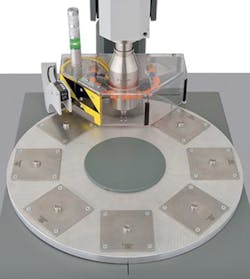Sonics & Materials, a pioneer in ultrasonic welding technologies, has responded to customer requests by developing a high-throughput rotary index table that can be used with its full line of ultrasonic plastic welders.
"Customers had asked for a semi-automated machine to match their throughput needs," said Brian Gourley, North American sales manager — welding product line for Sonics. "This gives them a higher level of throughput without the expense compared to a fully automated machine."
The Model 2050RT rotary table can operate in manual load/automatic unload or manual load/manual unload modes, and its integrated HMI offers programmable, variable-speed control.A safety guard with a hinged door surrounds the welder's horn to protect the operator. A laser part-presence sensor is mounted next to the welder, which is activated only when parts are detected. This avoids wasted motion and energy, allowing the table to run as quickly as possible.
An LED tower can work in conjunction with the HMI to convey feedback from the machine to the operator, such as good part/bad part status, and safety warnings.
"If we take the obvious, which is red/yellow/green, red could be stop condition, the yellow could indicate maybe a bad part, green would indicate a good part," Gourley said. "But we can go beyond that. So if a customer comes to us with a particular criteria for the light tower, we can write the PLC code to accommodate however they want the visual indicators to be."
The rotary table, which has a direct-drive motor and indexer, can be used with Sonics' standard pneumatic welding presses and stepper motor systems, and in the full range of assembly frequencies (40, 35, 30, 20 and 15 kilohertz). An optional painted steel machine base is available, with lockable rolling casters and a shelf for a power supply.
Gourley said that Sonics works with customers to understand their needs, and can tailor the final product to the customer's unique application. He added that such collaborations could result in a system with even greater flexibility. "So one machine concept might be able to satisfy multiple applications. By changing a horn and by changing the nests that are on the dial plate, we can accommodate a completely different application on the machine. One machine with multiple sets of tools can be a lot more affordable than having multiple machines."
Gourley said that table size, number of stations, HMI display and programming are just a few of the variables that can be customized. "As long as we can design it, we can machine it, we can program it — we can build it," he said.
David Tillett, copy editor
Contact: Sonics & Materials Inc.Newtown, Conn., 203-270-4600, www.sonics.com
About the Author
David Tillett
Associate Editor David Tillett writes and edits for Plastics Machinery & Manufacturing, Plastics Recycling and The Journal of Blow Molding. He covers new products, industry news, patents and consumer and business equipment. He has more than 20 years of experience in daily newspaper, online and magazine journalism.


